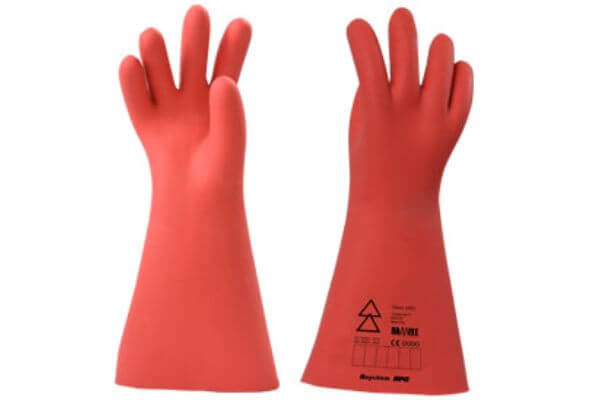ELECTRICAL SAFETY GLOVES
Insulating gloves are engineered to avoid electrical incidents. They act as a safe barrier to stiff conductivity and electrical transmission from a surface or ground to the human body. Operators of electrical maintenance as well as all the personnel working in an environment close to live current wires, arc flash, substation switchgear, power generations and likewise environments must wear electrical safety gloves at all times on the job.
What are the differences between the different classes of insulating gloves?
Electrical equipment safety is generally divided into classes: Class 00 to Class 4. These gloves for electrical shocks are fashioned to provide contact-level hand protection against electrical environments. Following a safety assessment, the correct class of insulating gloves should be chosen based on the voltage range, arc flash protection, and other electrical hazards. These personal hand protection gears have specifications like voltage insulation capacity, ozone resistance, acid, and temperature defiance, and wear and tear durability. For example, Class 4 insulated gloves provide dynamic 37kv protection, while Class 2 is resistant against lower voltages.

Furthermore, Class 3 dielectric gloves offer superior protection compared to Class 0. Not only that, but also, these insulation gloves must have reliable quality manufactured under global safety regulations such as IEC 60903 and EN 60903 standards that guarantee their safety by being tested individually before they’re released to customers. Moreover, apart from classes, electrical equipment gloves are classified under three major types.
Standard Version
Due to their non-resistance to puncture and abrasion, standard insulating gloves should be topped with electrical leather gloves due to the non-resistance to puncture and abrasion.
Tear Resistant Version
These electrical hand protection ppt are engineered to protect against mechanical tear and punctures. They require no over gloves, unlike standard varieties.
Version Tested according to ASTM D120
The American Society for Testing and Materials or ASTM is the industry’s most extensive and renowned advanced safety standard organization, which ensures the quality and claims of an insulating pair of high-voltage safety gloves throughout their use.
Gloves for electrical insulation Version
These must-haves insulating glove editions are based on field experience and safety expert opinions. Besides safety, you should consider ergonomic features, task suitability, comfort with a soft interior, and exceptional dexterity when choosing electrical insulating rubber gloves. Choose one that meets your needs below.
Insulating gloves provide personal hand protection for operators handling electrical and high-voltage currents in substation switchgear. To prevent electrical shocks, we offer five classes of electrical shock protective gloves, ranging from class 00 rubber gloves for electrical work to class four rubber gloves.
Our insulating gloves are also available in two main categories: standard rubber gloves for insulation, and mechanical insulation gloves such as inner linen gloves or top-layer leather gloves.
Useful Suggestions
You should always wear appropriate safety precautions and gloves when working around live wires, naked cables, or energized surfaces or equipment or when excavating around live cables. For reliable safety, electrical rubber insulating gloves must meet IEC 60903 and EN 60903 standards.
Contact Us
To provide enough protection according to the possible voltage exposure, the dielectric properties of each pair must be carefully selected. Our recommended electrical hand safety equipment is CATU insulating gloves, which feature outstanding dexterity as one of the most trusted brands on the market. You should always test your gloves for punctures before using them, follow the utility’s instructions, and avoid contact with electrical situations without wearing high-voltage safety gloves.

